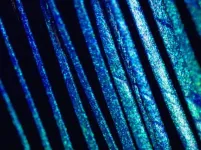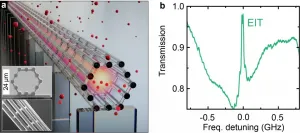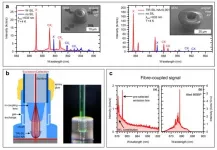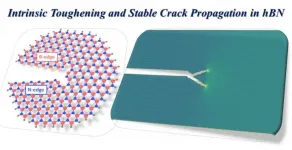Yale-NUS College scientist discovers how leafbirds make complex color-producing crystals
These mind-bendingly complex crystals called the single gyroid, found in blue-winged leafbirds, have the potential to make fiber optics, solar cells and fuel cells more efficient
2021-06-03
(Press-News.org) A recent study by a team of researchers led by Dr Vinod Kumar Saranathan from the Division of Science at Yale-NUS College has discovered a complex, three-dimensional crystal called the single gyroid within feathers of the blue-winged leafbird. Dr Saranathan and his team's breakthrough came from their investigation of the feather colours of leafbirds, an enigmatic group of perching birds endemic to South and Southeast Asia (including Singapore), one species of which has evolved the unique crystals in its plumage.
By comparing the colour-producing nanostructures present in close relatives, the team reported that this species is able to directly synthesise single gyroid photonic crystals, which have highly desirable optical and electronic properties that make them ideal for use in photovoltaic cells to generate solar energy. Use of this crystal - a "crowning achievement" in material science engineering which thus far has been manufactured only with great difficulty - has the potential not only to improve photovoltaic cells, meaning they can be produced more easily and cheaply, but also for use in other industrial applications like catalysis in fuel cells and fibre optics.
Published in Proceedings of the National Academy of Sciences of the United States of America (PNAS), this study is particularly relevant as the search for renewable sources of energy and sustainable manufacturing has taken on a fresh urgency.
Dr Saranathan, who holds a concurrent appointment at the National University of Singapore's Department of Biological Sciences, said, "Currently, we cannot industrially manufacture single gyroid photonic crystals to work in the visible light spectrum, via self-assembly, a process that spontaneously brings together nanoscale chemical 'Lego-blocks'. Larger crystals can be manufactured and then heat-shrunk to work with visible light, but so far this can be done only on a small scale and is not defect-free. Thus, our discovery of the first directly self-assembled single gyroid crystals known to science, found in these leafbirds, we think is revolutionary. The way leafbirds manufacture these crystals is much more straightforward than how butterflies (some of which use the same structure in their wing scales) or material scientists are known to do so."
"Our research provides a clear insight on the class of patchy particles like charged proteins that researchers can investigate in the future, to see if they can be coaxed into forming these crystals at visible light scales. Knowing how leafbirds manufacture these exotic structures can spur novel biomimetic eco-friendly self-assembly strategies for large-scale materials synthesis at these highly challenging optical length-scales, given the urgent ecological need for such materials."
INFORMATION:
The research team includes Dr Suresh Narayanan and Dr Alec Sandy from the Argonne National Laboratory, Professor Eric R Dufresne from ETH Zurich, and Professor Richard O Prum from Yale University.
[Attachments] See images for this press release:

ELSE PRESS RELEASES FROM THIS DATE:
2021-06-03
BUFFALO, N.Y. - College students who engaged in four or more high-impact practices such as study abroad or internships have a 70% chance of either enrolling in graduate school or finding a full-time job after graduating with a bachelor's degree, finds a new University at Buffalo study.
Each additional high-impact practice increased a student's chance of attaining a bachelor's degree and a full-time job by 17% or enrolling in graduate school by 30%, according to the study. These practices - such as study abroad, internships, undergraduate research, community service, first-year ...
2021-06-03
In the rapidly growing field of hybrid quantum photonics, the realization of miniaturized, integrated quantum-optical systems with intense light-matter interaction is of great importance for both fundamental and applied research. In particular, the development of methods for reliably generating, controlling, storing and retrieving quantum states with high fidelity through coherent interaction of light and matter opened up a wide field of applications for quantum information and quantum networks. These include, for example, optical switching, quantum memories, and quantum repeaters.
One promising approach for efficient light-matter interaction is the integration of light-guiding platforms in a near-room-temperature alkali vapor. Several research groups have aimed to ...
2021-06-03
Lithium is a vital element in the batteries that power electric vehicles, but soaring lithium demand is expected to exhaust land-based reserves by 2080. KAUST researchers have now developed an economically viable system that can extract high-purity lithium from seawater.
The oceans contain about 5,000 times more lithium than the land but at extremely low concentrations of about 0.2 parts per million (ppm). Larger ions, including sodium, magnesium and potassium, are all present in seawater at much higher concentrations; however, previous research efforts to tease ...
2021-06-03
Quantum computing and quantum communication are believed to be the future of information technology. In order to achieve the challenging and long-standing goal to make secure, wide-spread quantum communication networks a reality, high-brightness single-photon sources are indispensable. Single-photon emission from semiconductor quantum dots (QDs) has been shown to be a pure and efficient non-classical light source with a high degree of indistinguishability. However, the total internal reflection (TIR) as a result of the high semiconductor-to-air refractive index contrast severely limits the single-photon extraction efficiency. Another crucial step in the development ...
2021-06-03
For decades, researchers have debated whether the buildup of certain electrical activities in the brain indicates that human beings are unable to act out of free will.
Experiments spanning the 1960s and 1980s measured brain signals noninvasively and led many neuroscientists to believe that our brains make decisions before we do--that human actions were initiated by electrical waves that did not reflect free, conscious thought.
However, a new article in Trends in Cognitive Science argues that recent research undermines this case against free will.
"This new perspective on the data turns on its head the way well-known findings have been interpreted," said Adina Roskies, the Helman Family Distinguished Professor and professor of philosophy at ...
2021-06-03
Durham, NC -- Type 2 diabetes patients who are not overweight and who have had the disorder for less than a decade can benefit from stromal stem cells transplanted from their own bone marrow, according to a study published today in STEM CELLS Translational Medicine.
In a randomized clinical trial at Vinmec Research Institute of Stem Cell and Gene Technology in Hanoi, Vietnam, researchers investigated the safety and potential therapeutic value of administering bone marrow stromal stem cells to patients with Type 2 diabetes. In each case, the cells were autologous, ...
2021-06-03
SAN FRANCISCO, CA (June 3, 2021) -- Since arriving to the northern Atlantic Ocean less than 30 years ago, lionfish have quickly become one of the most widespread and voracious invasive species, negatively impacting marine ecosystems--particularly coral reefs--from the northeast coast of the United States to the Caribbean Islands. In a new study, an international research team including the California Academy of Sciences presents four new records of lionfish off the coast of Brazil, confirming the invasion of the predatory fish into the South Atlantic for the first time. Their findings, published today in Biological Invasions, discuss how the lionfish may have arrived in the ...
2021-06-03
A team of scientists led by Nanyang Technological University (NTU Singapore) and Rice University in the US, has uncovered the key to the outstanding toughness of hexagonal boron nitride (h-BN). h-BN can withstand ten times the amount of force that graphene can, which is known as one of the toughest materials on Earth.
A two-dimensional (2D) material, h-BN has a thickness of just one atom. First used in cosmetics in the 1940s, it was soon abandoned due to its high price, making a resurgence in the late 1990s after technology made its production cheaper.
Today, it is used by nearly all leading producers of cosmetic products because of its ability to absorb excess facial sebum and disperse pigment evenly, ...
2021-06-03
Mangrove vegetation, which grows naturally in subtropical shorelines, provides a wide range of ecosystem functions such as reducing coastal erosion, promoting biodiversity, and removing nitrogen, phosphorus and carbon dioxide. These vital ecological functions are influenced by the water flow around the intricate mangrove roots, which create a complex energetic process that mixes up sediments and generates a depositional region behind the roots. How these mangrove roots interact with water flow is believed to be a key element in mitigating coastal erosion.
Accurately projecting hydrodynamic erosion and the essential amount of mangrove species has been a challenge for managers and restoration experts to forecast a successful component of project designs. That is because ...
2021-06-03
WASHINGTON (June 3, 2021) - Nearly three-quarters of breast cancer patients (73%) report using at least one type of complementary medicine after cancer diagnosis, while oncologists believe that less than half (43%) of patients are using these approaches during cancer care. These and other findings from a national survey of oncologists and breast cancer patients were released in conjunction with the 2021 ASCO Annual Meeting. The study found that doctors report discussing integrative health with only about half of patients, leading patients to seek information outside the clinic.
"Cancer is a complex ...
LAST 30 PRESS RELEASES:
[Press-News.org] Yale-NUS College scientist discovers how leafbirds make complex color-producing crystals
These mind-bendingly complex crystals called the single gyroid, found in blue-winged leafbirds, have the potential to make fiber optics, solar cells and fuel cells more efficient





